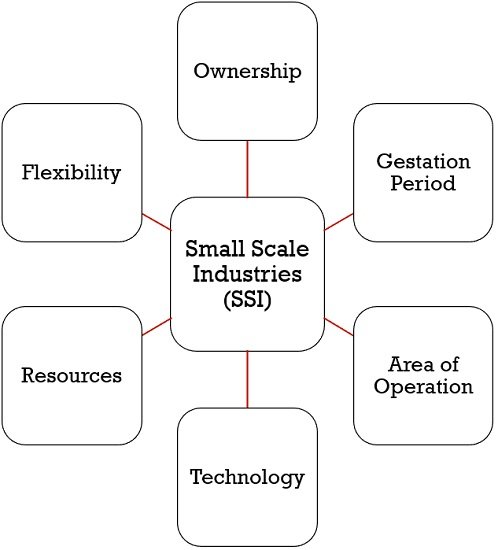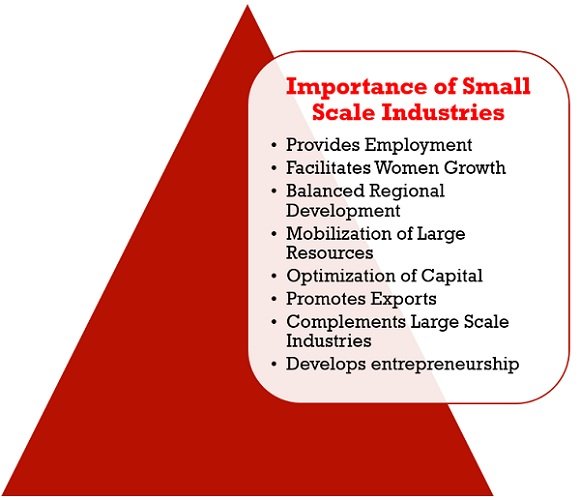Definition: Small Scale Industry (SSI) refers to an industrial undertaking whose investment in fixed assets, i.e. plant and machinery, is not less than ₹ 1 crore, be it is owned, leased, or hire purchased. Nevertheless, considering the needs of small-scale industries which are dependent on export promotion and modernization, the maximum investment in fixed asset is ₹ 5 crores.
They supply a large variety of products like readymade garments, hosiery items, handloom items, stationery items, soaps and detergents, plastic and rubber goods, wood and steel furniture, calculators, etc.
Example of Small Scale Industries in India
- Carpet making factories at Panipat
- Hosiery Factories at Ludhiana
Characteristics of Small Scale Industry
Small Scale Industries are characterised by:
- Ownership: A small-scale industry is owned by one person in case if it is a sole proprietorship and with few individuals in the case of a partnership.
- Gestation Period: In the case of small-scale industries, the gestation period is less as compared to large-scale industries. The Gestation Period in terms of business refers to the duration from the conception of an investment project until it starts providing a return on investment.
- Area of Operation: The area of operation of a small-scale industry is usually limited to a district, and caters to the demand of the localities. It uses a limited amount of resources and so the activities are confined to the local level.
- Technology: As we said earlier, small-scale industries are labor-intensive industries, which have significantly smaller capital influx. Hence, the units are appropriate for those economies where limited capital is used and there is enough labor supply.
- Resources: Local and indigenous resources are used by small-scale industries, and they can be found anywhere depending on their availability, i.e. they can be dispersed over a large area.
- Flexibility: Small Scale Industries are change susceptible in the sense that they are more reactive and responsible for the dynamic business environment. They easily implement change, adopt new methods and techniques of production, introduce new products.
Do You Know?
- Small Scale Industries in India constitutes around 95% of the industrial units.
- Approximately 40% of the gross industrial value-added and 45% of total exports are contributed by SSI.
Objectives of Small Scale Industry
- To increase employment opportunities for the marginalized groups and for the people living in backward areas.
- To reduce the economic backwardness of rural areas.
- To remove regional imbalances, by ensuring equitable distribution of income.
- To mobilize resources and ensure optimum utilization.
- To attain self-reliance and encourage self-employment.
- To raise the standard of living of people and improve the quality of life.
Importance of Small Scale Industries
- Provides Employment: Labour intensive techniques are used in SSI and so it provides employment to a large group of people, especially in rural areas, which may include artisans like handicraft makers, potter, weavers, metalwares makers, sculpturists. leather workers, etc., and also to professionally and technically qualified youth. Further, it provides employment opportunities to the people involved in traditional arts.
Important: SSI provides high employment in the rural and unorganized sector. They are the second-largest employer in India after agriculture. - Facilitates Women Growth: A high percentage of women workers can be found in Small Scale Industries. This not just provides better opportunities to them, but also develops entrepreneurial skills in them as a number of special schemes and incentive programs are run by the government to encourage women entrepreneurs.
- Balanced Regional Development: It is a well-known fact that the development level is high in urban areas, as compared to the rural areas. SSI encourages decentralized development as small scale units are mainly established in backward and rural regions. In this way, it removes regional disparities. It also initiates the government to develop infrastructural facilities in rural areas. Also, it helps in improving the standard of living of the people who live in rural areas,
- Mobilization of Large Resources: SSI helps in mobilizing and utilizing local resources which might not be tapped or remain unutilized otherwise. Not just this, it tends to promote, traditional regional or family skills and handicrafts which have a very high demand in foreign countries.
- Optimization of Capital: When it comes to per unit output, the capital required is quite less. Further, due to the shorter gestation period, the return on investment can be quick and the payback period is short. This acts as an incentive for the people living in rural areas, to mobilize their savings and use them for industrial activities. Moreover, it enjoys the benefit of the low cost of production, as the resources are available locally, which are comparatively less expensive
- Promotes Exports: It earns valuable foreign exchange by way of exports. Further, it does not requires heavy machinery to be imported from other countries. However, there is a very high demand in the international market for SSI produced goods.
- Complements Large Scale Industries: Parts, components, equipment and accessories required by the Large Scale Industries are provided by the Small Scale Industries. In this way, it complements and supports the Large Scale Industry to work smoothly.
- Develops entrepreneurship: SSI helps in developing a class of entrepreneurs in the country, which turns job seekers into job givers. It helps in the equitable distribution of national income among various members of society. Also, it encourages self-employment and develops the spirit of self-reliance.
A Word from Business Jargons
Initially, the term ‘Small Scale Industry is mainly used in the context of agro-based rural industry wherein huge capital investment and infrastructure is not required. But with the passage of time, electronic equipment, tools, handicrafts, and digital devices are also manufactured by small scale industries.


Hamsavi BL says
Useful information thank you